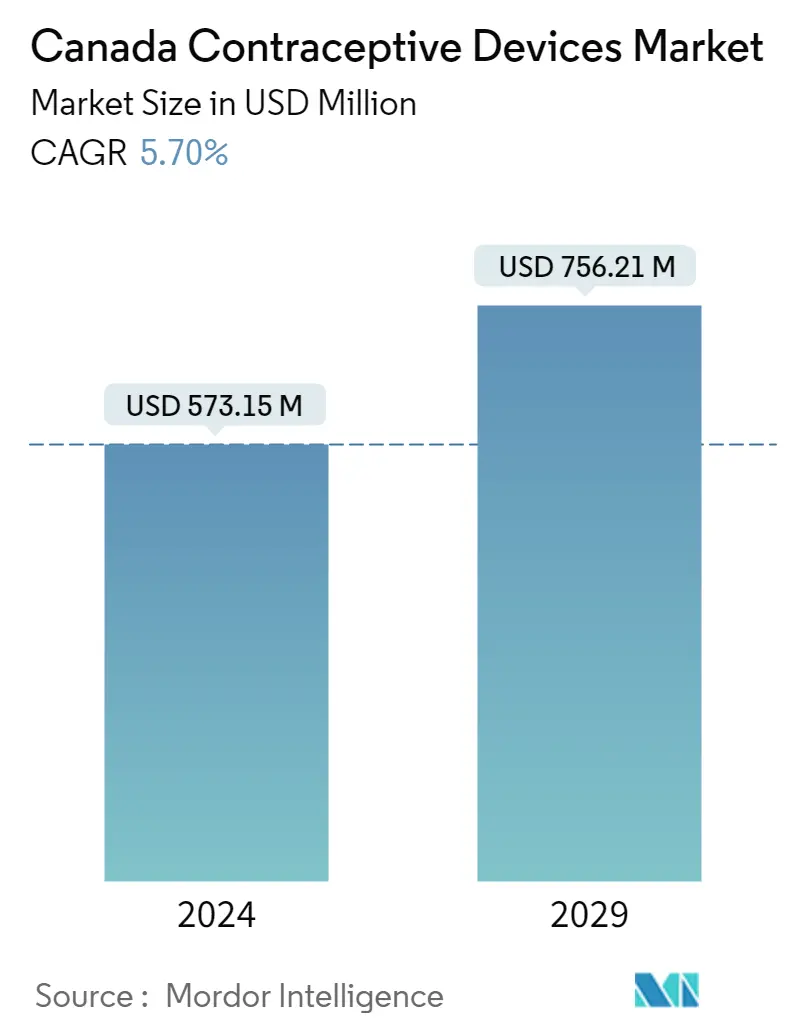Market Size of Canada Contraceptive Devices Industry

| Study Period | 2019 - 2029 |
| Base Year For Estimation | 2023 |
| Forecast Data Period | 2024 - 2029 |
| Market Size (2024) | USD 573.15 Million |
| Market Size (2029) | USD 756.21 Million |
| CAGR (2024 - 2029) | 5.70 % |
Major Players
*Disclaimer: Major Players sorted in no particular order |
Canada Contraceptive Devices Market Analysis
The Canada Contraceptive Devices Market size is estimated at USD 573.15 million in 2024, and is expected to reach USD 756.21 million by 2029, growing at a CAGR of 5.70% during the forecast period (2024-2029).
Due to COVID-19-related lockdowns, access to contraception was disrupted, leading to an increase in unsafe abortions, miscarriages, pregnancy problems, HIV transmission, and other STDs, as well as an increase in PTSD, despair, suicide, and intimate partner violence. These implications disproportionately affected marginalized communities in the United States and emerging nations, widening both domestic and global healthcare inequities. As per an NCBI article published in October 2020, the COVID-19 crisis is expected to result in 7 million unwanted births for more than 47 million women, according to research by the UN agency for sexual and reproductive health (UNFPA). According to another article published in July 2022, contraceptives are limited and expensive, particularly for people living in rural and underprivileged communities. In Canada, between 30-40% of pregnancies are unplanned. Thus, the increase in unwanted and unplanned pregnancies in the country is expected to increase the complications related to childbirth in women. That is expected to drive awareness of the usage of contraceptive devices, boosting the growth of the market.
According to the Government of Canada, data published in February 2022 showed that sexually transmitted infections (STI) were a significant and ever-increasing public health concern in the country. STIs are among the most common communicable infections affecting the health and lives of people worldwide. According to the Public Health Agency of Canada (PHAC) and the Canadian AIDS Treatment Information Exchange, data published in 2022 showed that the three reportable bacterial STIs in Canada are chlamydia, gonorrhea, and infectious syphilis. Chlamydia is the most common, followed by gonorrhea and syphilis. To avoid such diseases and their transmission, contraceptive devices are recommended, which is expected to drive market growth in the country.
A rise in the number of gynecologists favoring these contraceptive methods for birth control is anticipated to drive industry growth in the coming years. The increased use of safe and effective oral tablets increased awareness of modern contraceptives, and health issues associated with teen pregnancies contribute to the market's growth. Rising awareness in the Canadian population regarding contraception methods, investments by key players to develop innovative devices, and favorable government initiatives to improve access to products are the major factors accelerating the growth. The expansion of the Canadian market for testing for STIs is expected to be driven by an increase in STD cases among the population. Rising government initiatives to introduce new diagnostic kits and tests are expected to fuel market expansion. According to PHAC reports, syphilis cases increased to 9,126 in 2020. Thus, the increasing number of STIs and other infections promotes the usage of contraceptive devices and increases their demand, thereby expecting increased market growth.
However, the side effects of contraceptive devices have been restraining the market's growth.
Canada Contraceptive Devices Industry Segmentation
Contraceptive devices are barriers that attempt to prevent pregnancy by physically preventing sperm from entering the uterus. Contraception, more commonly known as birth control, is described as the method used to avoid pregnancy. It includes male condoms, female condoms, cervical caps, diaphragms, and contraceptive sponges with spermicide.
The Canadian contraceptive devices market is segmented by type (condoms, diaphragms, cervical caps, sponges, vaginal rings, intrauterine devices (IUDs), and other types) and gender (male and female). The report offers the value (in USD million) for the above segments.
| By Type | |
| Condoms | |
| Diaphragms | |
| Cervical Caps | |
| Sponges | |
| Vaginal Rings | |
| Intra Uterine Device (IUDs) | |
| Other Types |
| By Gender | |
| Male | |
| Female |
Canada Contraceptive Devices Market Size Summary
The Canadian contraceptive devices market is poised for significant growth over the forecast period, driven by increasing awareness and demand for effective birth control methods. The market is influenced by various factors, including the rising incidence of unintended pregnancies and sexually transmitted infections (STIs), which have heightened the need for contraceptive solutions. The COVID-19 pandemic has further underscored the importance of accessible contraception, as disruptions in access led to adverse health outcomes, particularly in marginalized communities. This has spurred a greater emphasis on contraceptive awareness and usage, contributing to market expansion. The availability of innovative products, such as vegan condoms and vaginal rings, along with favorable government initiatives and investments by key players, is expected to bolster market growth.
The competitive landscape of the Canadian contraceptive devices market is moderately competitive, with both international and local companies holding significant market shares. Key industry players, including AbbVie Inc. (Allergan), Bayer Healthcare, and Cooper Surgical Inc., are actively contributing to market dynamics through product launches and strategic initiatives. The increasing prevalence of unintended pregnancies and the demand for safe and effective contraceptive methods are driving the market forward. Despite the challenges posed by side effects associated with some contraceptive devices, the overall market trajectory remains positive, supported by the growing awareness and adoption of modern contraceptive solutions among the Canadian population.
Canada Contraceptive Devices Market Size - Table of Contents
-
1. MARKET DYNAMICS
-
1.1 Market Overview
-
1.2 Market Drivers
-
1.2.1 Increasing Awareness About Sexually Transmitted Diseases (STDs)
-
1.2.2 Rising Rate of Unintended Pregnancies and Rise in Government Initiatives
-
-
1.3 Market Restraints
-
1.3.1 Side Effects Associated with the Use of Contraceptive Devices
-
-
1.4 Porter's Five Forces Analysis
-
1.4.1 Bargaining Power of Suppliers
-
1.4.2 Bargaining Power of Buyers/Consumers
-
1.4.3 Bargaining Power of Suppliers
-
1.4.4 Threat of Substitute Products
-
1.4.5 Intensity of Competitive Rivalry
-
-
-
2. MARKET SEGMENTATION (Market Size by Value - USD million)
-
2.1 By Type
-
2.1.1 Condoms
-
2.1.2 Diaphragms
-
2.1.3 Cervical Caps
-
2.1.4 Sponges
-
2.1.5 Vaginal Rings
-
2.1.6 Intra Uterine Device (IUDs)
-
2.1.7 Other Types
-
-
2.2 By Gender
-
2.2.1 Male
-
2.2.2 Female
-
-
Canada Contraceptive Devices Market Size FAQs
How big is the Canada Contraceptive Devices Market?
The Canada Contraceptive Devices Market size is expected to reach USD 573.15 million in 2024 and grow at a CAGR of 5.70% to reach USD 756.21 million by 2029.
What is the current Canada Contraceptive Devices Market size?
In 2024, the Canada Contraceptive Devices Market size is expected to reach USD 573.15 million.

